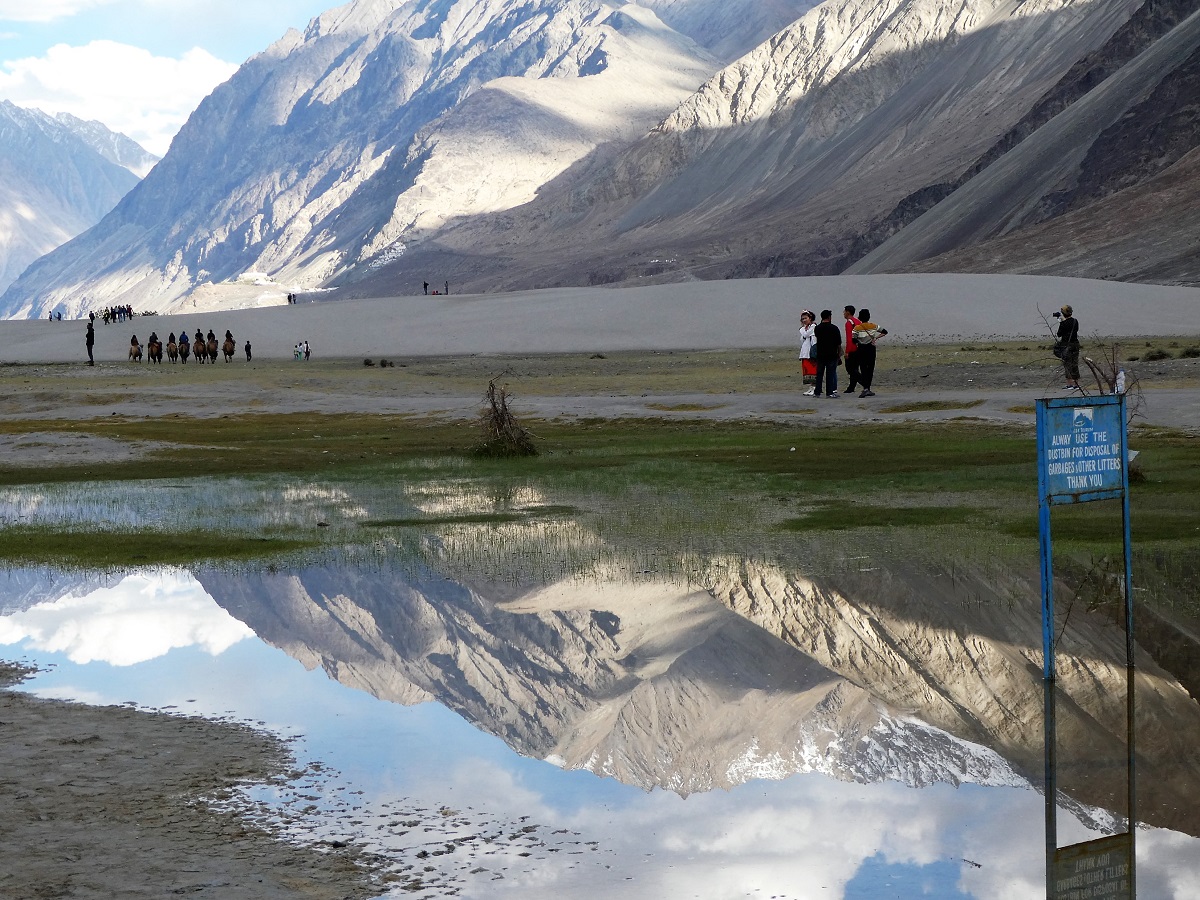own the valley from Khardung La Pass
We gasp with delight at the panorama of high peaks, steep-sided gullies, green river valleys and sheer drops – the shutters click and the videos whirr as the view is too much to fit in one frame. Once down off the high road we are able to travel faster on the once again sealed road and we pass through farmland that is being harvested in this autumn season under the high peaks on the plateaus above the deep river gullies. Yaks roam free in the fields and drink from the waterways, which carry snow-melt after winter and feed in the irrigation built from earth and stones to provide this beautiful valley with vital nutrients and moisture year after year.



We enter the wide Shyok river valley that stretches east and west and joins the Nubra River before flowing on towards Pakistan and into the Indus. White water rafting signs are posted on the roadside at river level as we drive through white sand cliffs that stretch right up from the edge of the road. We encounter many fellow travellers on motorbikes as they pass our way; this valley is a popular holiday and destination for exploration. We stop to take photos and one bike rider stops and asks for his photo to be taken on a strategic spot above the wide river valley.


Brief history of the area
The road to the Nubra Valley was originally constructed in the 1960s and at the partition of India in 1947 this area belonged to Pakistan. A bloody war was fought at high altitude in the Siachen Mountains (6,700m/24,000ft) and in 1972 India won this fight. The Nubra Valley then came back under India’s jurisdiction and, although it is part of Ladakh, this area has its own local government. The Indian army maintains a presence in Nubra and Siachen to protect the border which on the high Tibetan plateau was once a major trade route through the Karakoram and Sasser passes. The area includes the world-renowned and beautiful Siachen Glacier, K2 and the ‘line of control’, otherwise known as the Indo-Pakistan border. Read more here – about the origins of the beautiful Sia-Chun Glacier (Sia – flower, Chen – valley), the ongoing territorial issues and the harshness of the area – the effects on the precious flora and fauna due to the military presence where more soldiers have died due to the harsh conditions than from combat.


Nubra Valley: Precious and so beautiful
The tri-armed Tibetan plateau cold desert Nubra Valley is very wide before it becomes divided by a high mountain range to become two separate but significant valleys with the Nubra and Shyok Rivers running through them.

Still wide, each of these valleys experiences very little rainfall and vegetation hugs the rivers which are predominantly glacial fed. About three metres of snow falls in winter but melts quickly. Until 2010 travellers could only travel as far as Hunder in the Shyok Valley, but now one can drive to the end of the road at Turtuk, a Sufi village where tradition can still be observed and modern society has yet to have significant impact and influence.



The road divides in the direction of each valley and today we drive on a very straight and narrow sealed road across the vast river plain to the hills above the Shyok River. See map here The road runs along the hills past the Diskit monastery and the huge 10mt/33ft sitting Maitreya Buddha statue which is a symbol of peace and faces West towards Pakistan.



We drive on towards the silver white sands of the Nubra desert near Hunder (4,000m/10,000ft). We spot the double-humped Bactrian camels resting in the mid-day heat. Best known as pack camels on the silk road of yesteryear, they have roamed central Asia since ancient times. Konchock tells us they have come here from Mongolia. Although there are some which still roam free, these days most are domesticated (since 2,500BC); and here in the Hunder sand dunes, tourists ride them for the sheer pleasure and experience of doing so. They have a tolerance for high altitude, cold and drought, so fit the territory of the high cold desert plateau very well. Some interesting information is that the humps are made of fat and not water as popularly thought. The long eyelashes and sealable nose are to keep dust out in sand-storms and their two toes with a flat sole are an adaptation for walking on sand. Information taken from here


Glamping at the ‘Nubra Organic Retreat’
We drive on to Hunder and to our accommodation at the ‘Nubra Organic Retreat’ and are wowed by the glamping style tents we are staying in. Stone and wood with canvas sides, stone bathrooms and western toilets, we feel like we have arrived in heaven. You want to know more about glamping? Check this out…After lunch, I fall into my comfy bed and sleep for an hour until the sun drops down and I feel a chill in the air with the net windows. My diary notes say that ‘I fell into a state of unadulterated bliss’.

Once up, I wander the property photographing the organic garden with its apple and apricot trees, hammocks and chairs to relax in and the small babbling stream that runs through the property and provides a ‘Garden of Eden’ feeling.


Finally, the long-awaited camel ride in the Nubra Desert
Driving along we stop to take photos in the pools that reflect the mountains across the valley.

At the sand dunes, Suresh and Konchok purchase the tickets to ride and before I know it I am photographing the amazing looking camels. Then it is time to board my ride and with a degree of trepidation I am hoisted between the humps and leaning backwards with ahhh’s and ohhh’s as the camel stands up, back legs first then front legs to what feels like its full height of about seven or more feet! It’s a bit scary up here I think, as the camel is roped to its mate, and after smiles and fearful grimaces for the camera we lope off down the sand towards other camels with their leaders and a feeling of Lawrence of Arabia with beautiful damsels and the reality that I could fall off!! I survive this ordeal (which was really quite nice) and then we all walk to the top of the sand dunes to photograph the setting sun over the dunes and mountains in this remote and beautiful setting.


Diskit Monastery visit
Disket Monastery is aligned with Thiskey monastery (near Leh) and is one of the oldest in Ladakh (14thC). The minagery of old buildings clings to the precipice of the cliffs that on one side fall away into a deep ravine/river and on the other face out into the Nubra valley itself.


We walk up, about 140 steps, so Suresh tells us, to the meditation hall. Along the way we stop to look at the old wooden steps that lead to the river deep in the ravine – this is where the monks used to go to collect water. Prayer flags flutter in the wind attached somehow to the rock wall on the other side. Shoba pats the little kittens and has them wrapped around her neck.

We visit the protector room with its huge statues, as custom has it, covered, all except one. Konchok tells us the incredible story of this Mahakala statue and why it remains uncovered which involves warring kings and local protection. In the main meditation hall (gompa) we sit for some time to listen to the monks’ incredibly beautiful chanting that stirs the heart and soul of us all as we are generously served small bowls of warm butter tea by the young monks. This monastery has a small population of young monks in training who are happy for us to take their photographs.


We go over to the big Maitreya statue and observe the beauty of the valley from this high point. Its presence is powerful and commanding. It reminds one of its peaceful purpose in Buddhism and that it represents the Buddha to come. Further, that Buddhism will continue into the future at a time when its teachings and dharma will be all but forgotten which is an interesting prophecy that dates back to the previous Buddhas. Many Maitreya statues are seen all over Ladakh.




The other arm of the Valley
Leaving Diskit we drive back across the long straight road on the river plain and turn left at the bridge to travel along a narrow road through small villages and past farms up the Nubra River arm of these two valleys. Visiting Summar monastery, aligned with Diskit, where there is also a Buddhist nunnery, the statues in the meditation hall are beautiful and the recently painted wall art and outer complex shine with new paint. Here we could photograph these forms. The Shakyamuni Buddha statue is particularly beautiful in gold and bronze and really takes my eye and my camera shutter.


We drive on to some natural hot sulphur springs at Panamik (3182mt/10,442ft). The hot pools were used for treating and healing particular ailments in times gone by but today the hot pools are visited by travellers like ourselves for a ceremonial dip. Panamik is as far up the valley as travellers can go on the required permit allowed in these valleys and is on the way to the restricted military area of the Siachen Glacier. The water is very hot as we tip it over our bodies, too hot to get used to and too hot to enter the pool. Back in Hunder that evening we enjoy a cultural event of folk dancing in a yurt set up for the event and watch the local ladies in traditional dress perform their dances and invite the audience to participate and join them for photos.

The drive back to Leh
We rise early and after breakfast, enjoy patting the black and white donkeys at our car park. Again we take photos.

We drive back the route we came and again the canvas spread before us offers amazing views as the overnight snow is now right down in the valley. The sprinkling on the lower slopes provides a salt and pepper effect on the rocks and low hills whilst the tops of the high mountains peer through the stormy grey clouds to reveal their thick coating of pure white beauty.



Just below the saddle, which forms the pass, motorbikes slowly skid from side to side as they traverse the slippery downhill slopes.



We wait until some traffic passes and, to our great surprise, around a corner comes several people with ski poles but no skis walking slowly in the snow. Konchok tells us they are training for a marathon to which we are both bemused and flabergasted!


We move on to take tea and snacks on the top of the pass. The fresh snow has created amazing opportunities that were not there a couple of days before and we enjoy taking more photos as it begins to snow yet again.



Back in Leh we enjoy the bliss of hot showers and hot lemon tea whilst musing our next short trip to Tsomorori Lake; and then with a wander around the markets and local shops we buy presents for those back home who are missing this amazing journey.



#himalayas #nubravalley #camelridinghundernubra #khardunglapass #ladakhindia #traveltheworld #funinthesnow #nubraorganicretreat #buddhistmonasteriesladakh #himalayanadventures #india #travel #traveltheworld #worldtraveler #amazingtravelexperience

